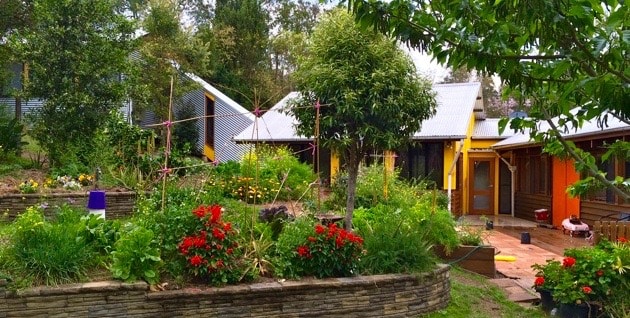My food garden is also my medicine chest.
The fresh healthy foods eating straight from the garden bring so many health benefits, but so do the many herbs, flowers, fruits and weeds that can be used as refreshing and healing teas.
 |
| My edible lanscape wraps around the house – food, spices, teas and natural remedies always at hand. |
Two of my favourite garden teas are Rosella and Lemon Myrtle, and Lemongrass and Peppermint. I love their colours, aroma and taste. Uplifting, refreshing and cleansing.
 |
| Maia and Hugh enjoying a cup of iced rosella tea. |
As I walk through my garden, I realise there is just so much more to be known and understood about each and every plant. My garden is a constant source of wonder and inspiration for inquiry.
Here is a small selection of teas that can be made from plants in a permaculture garden, and a brief listing of just some of the benefits they can bring. There are of course so many more healing herbs, flowers, fruits and roots – and so many more benefits from these plants…
Chamomile Chamomile tea aids to reduce stress and helps digestion. It aids peaceful sleep and reduces the problems of insomnia.
 |
| Chamomile |
Chickweed – while sometimes considered a nuisance by gardeners, it can be eaten like spinach, and makes a nice salve. As a tea, it is useful for bronchitis, coughs, colds, hoarseness and inflammation.
 |
| Chickweed |
Dandelion – a natural diuretic and digestive aid, rich in potassium, an excellent source of vitamin A, and protects against iron-deficiency. Dandelion tea is made from leaves and flowers.
 |
| Dandelion |
Elderberry – Useful herbal tea for headaches in colds, and a blood purifier.
 |
| Elderberry |
Ginger – so many benefits – an amazing plant. Ginger tea, amongst other things helps with digestion and circulation, relieves nausea and restores appetite. Also good for morning sickness and motion sickness.
 |
| Ginger root |
Gota Kola – provides support for healthy memory function, energises the central nervous system and rebuilds energy reserves, helps to combat stress and depression, has a positive effect on the circulatory system, is a mild diuretic and speeds the healing of wounds.
 |
| Gota kola |
Lavender – relaxes and helps people sleep and feel calm. The dried purple, white and pink coloured flowers are used. It helps to reduce respiratory issues, cough, asthma, bronchitis and body temperature – used for treating fever.
 |
| Lavender |
Lemon Balm – A tea of lemon balm also induces perspiration when trying to break a fever. The tea is used to reduce stress, calm nerves, and to lower insomnia and anxiety. It increases the capacity of our memory and refreshes our mood. It lowers the problems of stomach, digestive system and flatulence.
 |
| Lemon Balm |
Lemon Myrtle – many benefits – said to relieve muscle cramps and spasms, rheumatism, headaches and fevers. The anti-oxidants in citral help boost the immune system. It is an refreshing and calming tea.
 |
| Lemon Myrtle – an Australian native tree. |
Lemon grass – purifies the whole body. Helps digestion, cleanses and detoxifies, and relieves arthritis.
 |
| Lemongrass cut for tea |
Peppermint – a soothing tea – reduces the problems of vomiting, motion sickness and nausea. It strengthens the immune system and gives the body protection against mild coughs, mild asthma. It also helps to clear congestion, and reliece mild aches and pains, as well as supress appetite.
 |
| Peppermint |
Rosella Tea is made from dried hibiscus flowers. High in vitamin C. It helps to reduce hypertension, cholesterol and blood pressure. The presence of anti-oxidants in rosella tea gives protection against cell-damaging free radicals.
 |
| Rosella bush |
Strawberry leaves – the dried leaves make a great tea that is a tonic and tones up the body’s intestines and appetite. It cleanses the stomach and is good for eczema and to prevent night sweats.
 |
| Strawberry leaf |
Tarragon – The health benefits of tarragon tea include its ability to relieve depression and anxiety. It helps relax the nerves and regulates the circulatory system. It also helps relieve fatigue, and induces a feeling of well being.
 |
| Mexican tarragon |
Tulsi – known for its rich antioxidant and adaptogenic properties that are known to promote wellness by building the body’s immune system, reducing stress, and promoting mental clarity.
 |
| Tulsi tea – also a bee attractor. |
Thyme – an expectorant and disinfectant, and known for its antifungal properties. Valuable in whooping cough, asthma and and lung troubles. A good remedy for bowel gas and cramps in stomach. Can also relieve headaches.
 |
| Thyme |





















We grow many of these herbs at Beelarong Community Farm and it's so good to learn more about their uses. It also encourages me to use them. Looking forward to more herb teas.
I learned something new from your blog post today. I had no idea about the strawberry leaves and will have to dry some and try it. I have bad hot flashes from menopause during the night and am looking for more help managing this.
Great info. Inspiring and helpful. Thanks.
some great herbs there, you can also use scented geraniums too, peppermint being the favourite :))
love thyme, have lemon thyme & wild thyme here
am working on getting more herbs growing but i only do 2 at time & get established before delving in for more.
strawberry leaves? never knew you could use those
great post
thanx for sharing